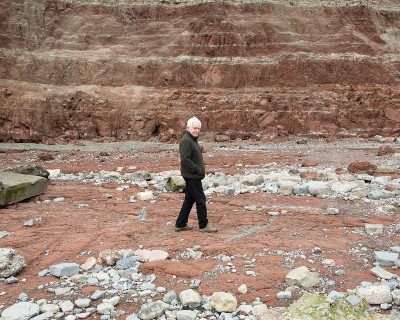Sam Phillips meets Terry Setch RA
Sam Phillips meets Terry Setch RA
Life on the edge
By Sam Phillips
Published 22 May 2014
Continuing our series on artists’ epiphanies, Sam Phillips visits the Welsh beach that transformed Setch’s art.
-
From the Summer 2014 issue of RA Magazine, issued quarterly to Friends of the RA.
The landscape inhabits Terry Setch RA. Since the London-born artist moved to Penarth in 1969, he has been utterly bewitched by the Welsh town’s coast, its rugged cliffs and beaches casting a heady spell over his art and life.
The Severn Estuary environment is more than just his subject: for over four decades these shores have provided the physical materials for his mixed-media works and acted, Setch tells me during a cliff-side stroll, as an ‘open-air studio’. The natural substances and man-made debris he finds on the beach – from sand and seaweed to plastic bags and corroded metal – are then often layered en plein air, amalgamated with acrylics and wax on board and canvas. Works in progress are even dipped in the water. Nature in this way becomes Setch’s unlikely studio assistant, and the results range from representational images to more abstract accumulations, some of which are on show this summer at Flowers Gallery in London.
-

Terry Setch RA on Penarth Beach in South Wales

Terry Setch RA on Penarth Beach in South Wales

Penarth Beach in South Wales

Terry Setch RA walks in front of the cliffs of Penarth Beach in South Wales, where he gathers the materials for his paintings

Penarth Beach in South Wales

In the studio of Terry Setch RA

Terry Setch RA's studio in South Wales

Terry Setch RA in his studio

Terry Setch RA's studio in South Wales
-
As we walk, I ask the Academician, now 78 years old, to cast his mind back to the year he was pulled into Penarth’s grasp. Why did the beach take hold of him? ‘The coast reminded me of where I was born. My dad was a welder who worked on the Thames, on the Isle of Dogs, and I had wonderful memories of the bending river. So in Penarth it felt that I had entered into entirely unfamiliar yet familiar circumstances, which was very liberating. I was immediately drawn to find a physical connection with that beach, which meant breaking completely with what I was doing.’ At that time what he was ‘doing’ was a cool and considered line of Pop art – the antithesis of his practice that followed.
‘The Severn has the second-highest tide in the world,’ he continues, ‘and when I first got here the shipping lane was still active. There was flotsam with jetsam – tyres, oil and tar slicks, rope, polystyrene crates. Incorporated into the paintings these metamorphose and become a part of my art language.’ A key moment came when he discovered an entire car marooned on the rocks, 40 years ago. ‘It was the violent intrusion of something grotesque at a time when I was becoming more politically conscious of waste and pollution.’ Over months it was gradually stripped and ripped up by the tide, before Setch painted it and then set it alight. Burning has been a metaphor as well as a procedure in his work, a signifier of transformative processes in the natural world.
Somehow, through some strange alchemy of his own, Setch has pursued an art that borrows from but is not defined by movements, from the 19th-century landscape tradition to post-1960s scenes such as Land Art, Action Painting, performance art and Neo-Dada. The artist he mentions most, however, is Alfred Sisley, the Impressionist who painted the very beach on which we walk. ‘I always want to break from the purity of a particular genre of art,’ Setch explains. ‘But I think people find it difficult that I connect artists who are not normally associated. I join tradition with modernism and it’s uncomfortable. I also share with nature, and that’s the way it should be – sometimes I think I should bring all my work down to the beach and let it be carried into the sea.’
Terry Setch is at Flowers Gallery, London from 12 June–12 July 2014.












